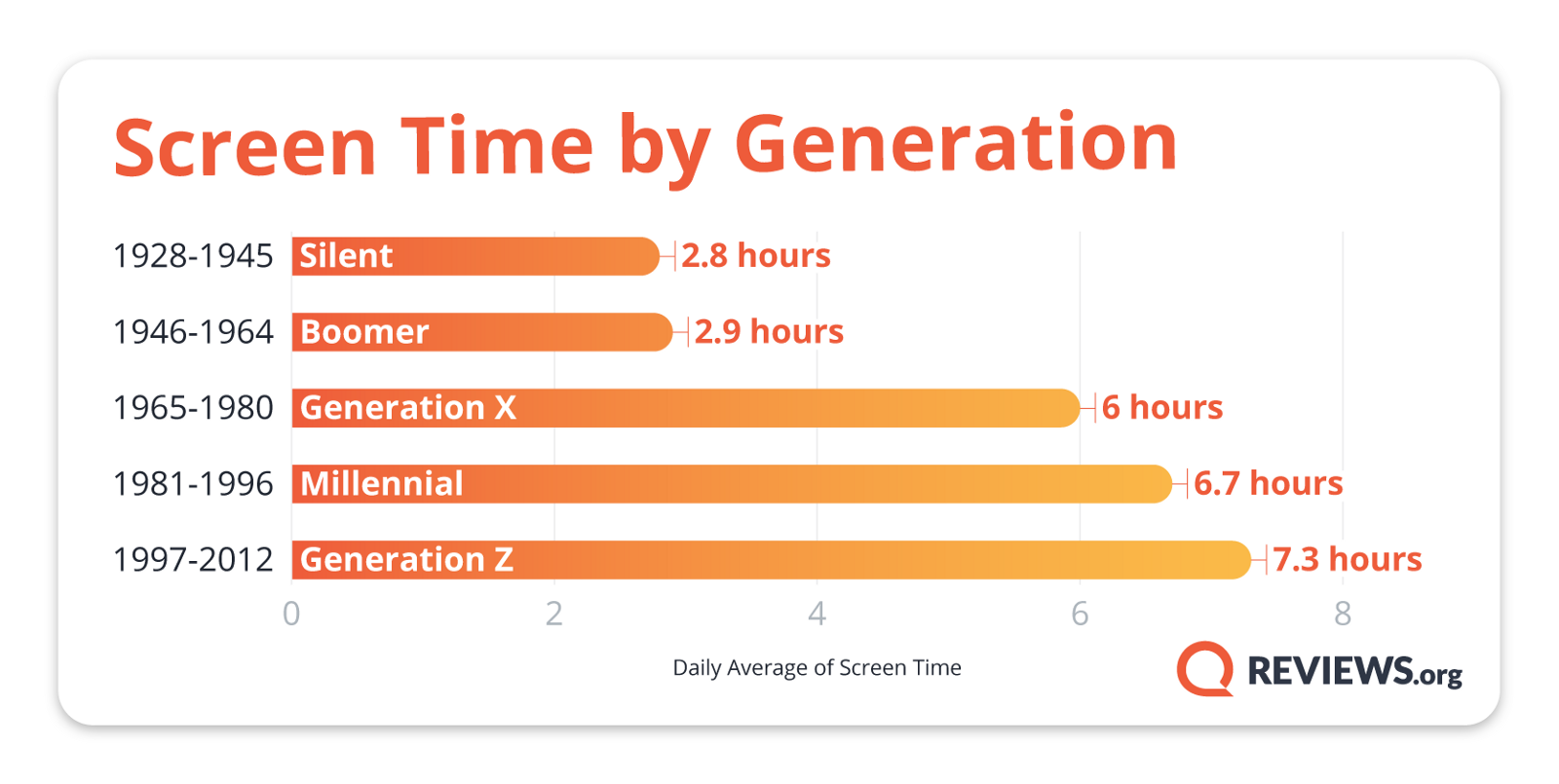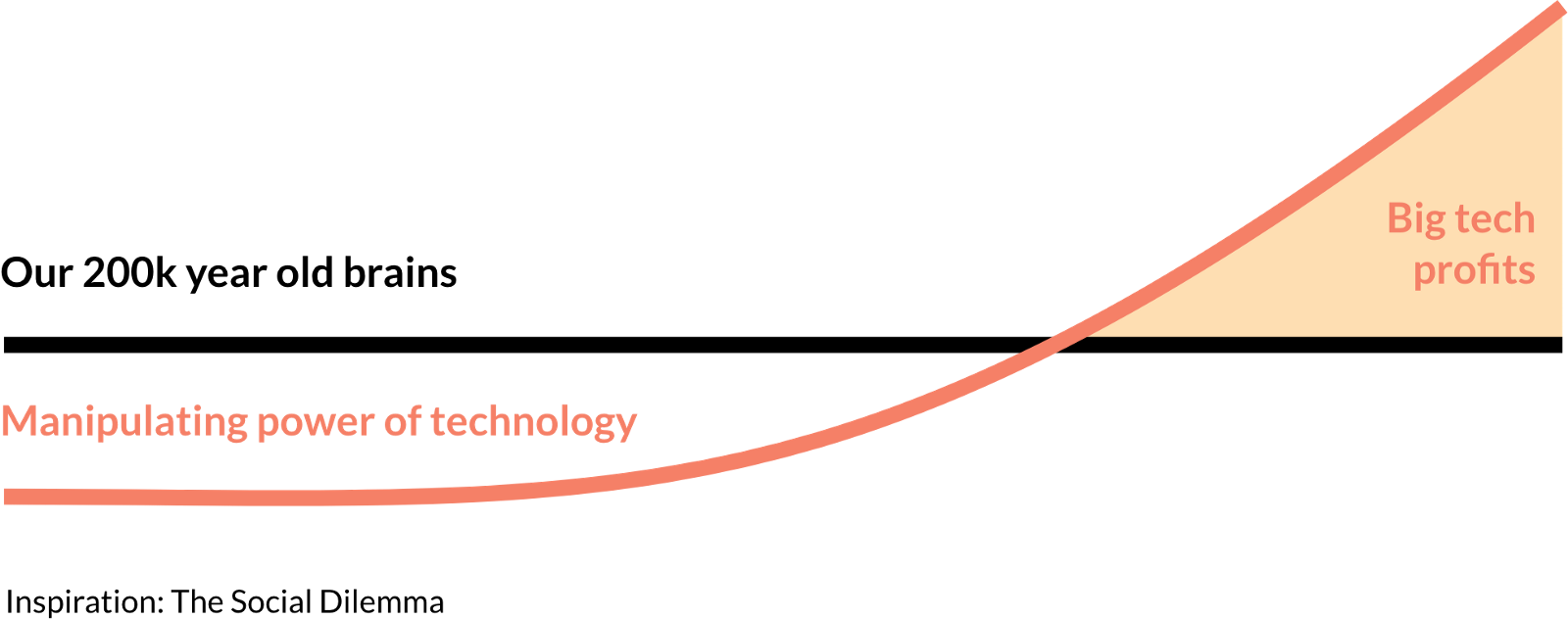You're here because you realise you have a problem with your focus.
You're not alone.
For many it's too awkward to acknowledge. Ignorance is bliss, but this is such an impactful issue on the quality of your life that I would go as far as saying it is your moral right to know and understand the 4 reasons propagating this problem.
How do our brains focus?
To understand the underpinnings of what is going wrong, we need a simple understanding of our consciousness. Fundamentally, our brains are constantly dealing with information from our senses. Information enters consciousness either because:
- We intend to focus on it, or
- As a result of attentional habits based on biological or social instructions
What is happening in your brain when you can't focus or concentrate?
When our attention is directed towards things based on habit, by definition, the information in question is not something we actively want to focus on. Although habits can be incredibly useful, this is one massive way we often come unstuck.
The brain has a theoretical limit on the amount of data that it can process, which means the information we allow into consciousness becomes extremely important as it determines the content and quality of life. What we focus on really defines our experience on this planet. To make it explicit, the information we process unintentionally is a drain on our attentional resources, leaving fewer resources for intentional focus.
If you peel back enough layers, you can attribute any distraction or lack of focus to the biological and learned attentional habits. These have developed through at least one hundred thousand years of human evolution and manifest as subconscious biases and instincts. As Robert Cialdini explains, our brain capacity has limits and such automatic habits can actually help ease cognitive decision load and make faster decisions:
For the sake of efficiency, we must sometimes retreat from the time-consuming, sophisticated, fully informed brand of decision making to a more automatic, primitive, single-feature type of responding. — Robert Cialdini
Whilst such shortcuts usually work to our advantage, the trigger features that activate these biological and social instructions can also trick us into relying on them at the wrong times.
The 4 big causes of lack of focus and concentration
1. Our brains didn’t evolve to focus on knowledge work
The vast majority of the time humans have been on Earth our priorities have been very simple — getting food and shelter. Only very recently in comparison, we have undergone a major shift in our priorities towards making money, looking after our families and making many complex decisions.
We are faced with an ever-changing array of problems to solve, which are ideally solved with deliberate focus for flexible problem solving. The trouble is our learned attentional habits are still triggered frequently in a world where we have completely different goals from our hunter-gatherer ancestors. To illustrate the extent of this, we are susceptible to at least 180 known cognitive biases. These biological instructions really limit our capacity to focus our attention on the things we wish to carefully focus on. If you allow yourself to imagine a little, it’s almost as if we have a little monkey in our heads tugging at us to cave in to our biological desires, in a constant battle with the rational side of our brain.
In the process of growing up, we get educated and get a job and we end up learning some positive attention habits from our social environment such as how to study and how to work in an office. However our biological instructions remain ever-present and, because we are not taught explicitly how to focus, procrastination and distraction have always been notoriously difficult to avoid.
The historical difficulty of focus
The greatest thinkers throughout recent history have understood the importance of deep focus and many have subsequently gone to great lengths to attain it.
In 1922 the famous psychiatrist Carl Jung began to build a retreat in a small village called Bollingen, on the shores of Lake Zurich. He called it the Tower. There was no electricity and no one was allowed to enter his private office. He did not build the Tower as a place to vacation but instead for a place where he could ignore the busyness of his counselling practice in Zurich to develop deeper and more careful thoughts that would see him become one of the most influential thinkers of the twentieth century.
It is unlikely that the Tower was the reason for his success, but what we can take away from this is a strong indication of the importance Jung placed on his focus and how Jung felt his attentional habits were so unproductive in the busyness of the city that it warranted the building of his tower.
2. We're overloaded in the age of unprecedented information
Technology has enabled an information age that has brought a level of hyper-connectivity that has never been seen before. It is well out of the scope of what evolution has prepared us for and as such has put our capacity to focus under more stress than ever.

Let’s take email for example — an amazing technology that has enabled free communication across the world and better collaboration which has helped develop even more innovations.
It also happens to tap into some of our biological instructions related to seeking and giving social validation. When you receive an email from a colleague or boss, you feel compelled to open it and reply. You experience similar feelings when you get a text message from a friend.
This started out as a perfectly harmless byproduct, however as we are now connected with each other through our devices 24/7, due to the way online communications naturally play to our inherited attentional habits it has created a much bigger unfortunate unintended shift. That is a huge transition from scheduled communications to constant unscheduled communications.
Whilst at first glance this sounds subtle, in effect, it means we are now constantly interruptible. And an interruption is actually a distraction, as it is something you don’t anticipate and is not relevant to what you are focusing on, at least in the short term.
Attention residue
Some might wonder if it even matters if we choose to communicate throughout the day in short periods rather than big blocks of scheduled communication.
Not only is our attention limited in capacity, but when we switch between two or more tasks part of our attention often remains stuck thinking about the original task. We call this concept attention residue. It is very difficult to transition our attention away from an unfinished task or one without a distinct time defined endpoint. So when we constantly switch between tasks we end up in a semi-distracted state and our cognitive performance suffers.
When our attention switches between tasks for just a short period of time and within the same topic it’s not so detrimental. Even still though, one study found that workers switched between different work spheres (activities within a similar context such as Microsoft Word and a related phone call) every 10 and half minutes. With so much transition, it is very difficult to think deeply and achieve flow.
It is generally counterproductive if you’re working on one task and you’re interrupted to shift your attention to a completely different topic.
People have to shift their cognitive resources, or attentional resources, to a completely different topic. You have to completely shift your thinking, it takes you a while to get into it and it takes you a while to get back and remember where you were. — Gloria Mark
Once you have shifted your attentional resources like this it takes an average of 23 minutes and 15 seconds to get back to the task.
In fact, one experiment showed that even the mere presence of our devices takes up some of our attention. Our brains have learnt to associate phone usage with entertaining stimuli and keeping such typically task-irrelevant information from entering our consciousness uses attentional resources in itself. With our phones turned to silent and face down next to us as opposed to being in another room both working memory and the ability to solve new problems are drastically reduced.
3. Our environment is engineered to distract us
It has always been possible for individuals to hack others’ short-term attention, beliefs and feelings by manipulating the very instincts and biases we have been talking about. Magicians, politicians and marketers are all examples of this. However, it has never been possible to do so at such scale and with such precision as in the last 15 years. A select bunch of companies now have so much influence over us that they do not just manipulate our short-term attention, beliefs and feelings but also our attention for long periods of time.
Now 95% of Americans between the ages of 18 to 50 have a smartphone sitting in their pocket. And they’re filled with different social media apps. Social media began as a great tool to help us connect with our family, friends and like-minded people. And it still is, but somewhere along the way these companies unknowingly overstepped their ethical boundaries and are now taking more attention than we want to give them. Social media no longer serves us — we serve it.
Australian Gen X, Millenials and Gen Z all spend more than 6 hours of their day on average looking at their phones. That’s more than a third of their waking hours.

Throughout the hours you use your device, your apps send you notifications and feed you hyper-personalised photos, videos and posts that the Artificial Intelligence (AI) algorithms behind the curtain knows will keep your attention for as long as possible. The more you use these apps, the more data they get on what works, and the better they get at keeping you engaged for longer. In other words, given the amount of time we spend on our devices, algorithms like these allow companies to influence our biological and social instructions to capture your attention on a continual basis. And no one is immune: anyone from psychologists to plumbers all fall prey to the same biological and social instructions that social media so effectively manipulates.
How does the attention economy impact your focus?
Many of the most successful tech companies today are using the advertising model. They generate revenue for each ad they run. To maximise the number of ads they can run, companies optimise for the length of time they can keep ‘users’ on their app.
“There are only two industries that call their customers ‘users’: illegal drugs and software.” — Edward Tufte
Those confident in the mechanics of markets above all else would argue that consumer choices drive the companies that produce the most value to win. However, the sad reality here is that the companies who are winning are being rewarded for exploiting and exacerbating our focus problem.
The secret to their addictive design: instant variable rewards
In order to maintain high rates of ‘user’ engagement, these companies have formed well-designed loops of pleasure around their products that have created an unconscious dependence on checking these apps routinely.
Nir Eyal outlines the cyclic process companies use to hook users into using their products habitually:
- Attach the use of the product to an emotional or external trigger
- User takes action
- User is given an instant variable reward
- Investment that improves the likelihood of future use
The process companies use to subconsciously gain our attention time and time again is a well-known science. And unfortunately, the more profitable companies can invest more resources into better executing this process.
Why we spend too much time down YouTube rabbit holes
It’s scary to know just how easily these techniques can influence our subconscious without our conscious knowing it at all.
More than 70% of the videos viewed on YouTube come from the recommendation algorithm which suggests new videos after you have finished watching the video you went there for. As convenient as these suggestions may be, it is not uncommon for people to spend hours watching video after video only to realise they probably shouldn’t have.
Lately a new term — doomscrolling — has sprung up to capture a phenomenon that many people have noticed about their social media use. It is compulsively scrolling through content on social media despite it being depressing or worrying. Evidently, this goes to show that we don’t consciously intend to spend so much of our attention on social media, but because it can so effectively control our attention we end up doing it anyway at the expense of our focus.
The progression and trajectory of the attention economy
The economic incentives at play are only providing more fuel to engineer even better ways of capturing more attention. At the end of the day a company must serve its shareholders. The typical shareholders’ demands profits.
Under this business model, one of the avenues that attention economy companies grow profits is by designing more effective ways of capturing attention. As a result, big tech is pouring more and more money into learning how to hack our brains weaknesses more effectively. Tristan Harris aptly names this vicious cycle the ‘race to the bottom of the brain stem’.

We are already well past the point where the manipulating power of technology could overpower our brains weaknesses. As computing power continues to grow exponentially, the ability for technology to process data and hyper-personalize their manipulation strategies is only getting better. Combine the financial incentives at play with the exponential growth in computing power and we have a problem that is growing very, very quickly.
4. Tech is learning to be more addictive
There’s no doubt that all these reasons behind our shrinking ability to focus are confronting. But what is the consequence when all this happens consistently over a long period of time? A host of even more extreme and nuanced problems have arisen which each further degenerate our focus.

You might be addicted and you don’t even know it
This is more common than you may think. A survey from 2012 suggested that two-thirds of smartphone users show signs of nomophobia, and in the 18–24 age group 77% of smartphone users show signs of nomophobia.
Mobile phone addiction is difficult to measure, but has a strong relationship with ‘Nomophobia’ — the fear of being without a mobile phone. A study by Yildirim and Correia set out to develop a simple questionnaire to figure out if you have it. To give you a taste, here are three of the statements you are asked to consider:
- If I did not have a data signal or could not connect to Wi-Fi, then I would constantly check to see if I had a signal or could find a Wi-Fi network
- If I did not have my smartphone with me I would feel nervous because I would not be able to receive text messages and calls
- If I did not have my smartphone with me I would feel weird because I would not know what to do
Each response is rated on a scale of 1 (“completely disagree”) to 7 (“strongly agree”). If you scored >3 out of those 3 questions, you are likely to have some form of nomophobia.
A survey commissioned by TeleNav shows that one-third of people would rather give up sex than their phone for a week. So even if you don’t want to call it an addiction, it is at the very least an unusual level of attachment.
Heard of phantom vibration syndrome? It’s when you falsely perceive that your mobile phone is ringing or buzzing even though it clearly isn’t. 89% of mobile phone users experience phantom vibrations at least occasionally.
And then you have the issue of how addicted kids are. Many young adults have grown up with a smartphone in their early teens. Some kids these days grow up with iPads from the age of 2 — and those devices are designed to completely hook them into using technology before they’re even in high school and able to think for themselves.
Is your phone making you dumber?
Social media and other highly stimulating apps also have a range of consequences on our longer-term cognitive function:
- A study by Sharifian and Zahodne found that the level of social media use on a given day is linked to a significant correlated increase in memory failure the next day.
- Using randomized controlled trials, one study found that 3 months after starting to use a smartphone, users experience a significant decrease in their mental arithmetic scores.
- A meta-analysis of several dozen research studies indicates that higher levels of switching between different media channels are significantly linked to lower levels of both working memory and long-term memory.
The unknown effects of technology on our brains...
There are many more related issues associated with heavy social media and device usage that we either haven’t got into here or we haven’t realised yet.
Why most of us haven’t noticed
You would think that from 2000 to 2020, a period in which transistor counts (a proxy for computing power) have gone up almost 1000 times, that productivity would increase.

But Cal Newport believes productivity growth has actually been stagnant. The productivity-beneficial parts of all this technological innovation combined with the extra overtime hours we appear to be working are only just outweighing all the drawbacks that the modern world has for our focus.
The long-term path out of all this
Will there be a point where all our attention is hijacked by outside influences and leave us no space to focus? Unless something drastic changes I believe this is a matter of not if but when.
If we, humankind, want to keep progressing we need to start using technology differently. The benefits of technology have been incredible and truly life-changing, however, we are advancing so quickly that we cannot effectively control the negative byproducts of these technologies. By the time we realise there is a problem and actually start fixing it a lot of irreparable damage has already occurred.
So we have a huge responsibility—if technology development continues on the trajectory of serving a small number of companies and sacrificing our autonomy for pleasure, it is hard to imagine a scenario where we do not end up in a dystopia.
Is there a way to solve our focus problem?
The best attempt at a solution we have as of now is for the tech industry to rethink its goals. It needs to start developing technology that empowers us to maximise our communal activities and our own personal development whilst fostering our mindfulness and awareness.
My suggestion for technologists
Go check out the Center for Humane Technology. They have the best framework I know as of yet to help guide us through the very difficult task of building a truly better future with technology.
What you can do right now to improve your focus
Luckily there are some easy and effective tips you can act on right now. A great place to start is learn strategies to reduce the impact your screens have on your focus, such as by limiting notifications and scheduling your time for both focus and periods of distraction.






